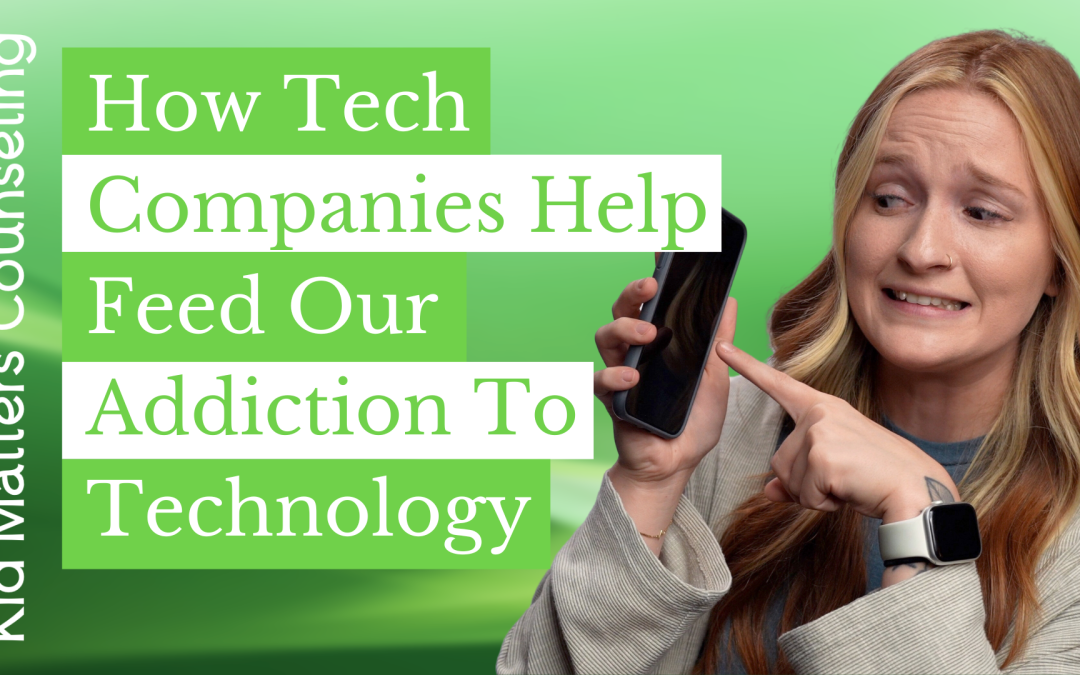Many parents feel like they are constantly battling with social media and screen time for their children’s attention. You probably find yourself looking around your home and your child is stuck to their phone.
If you were to walk through a middle school or high school, you won’t see kids talking to each other at their lockers. What you’d most likely see are students walking, heads down, bumping into each other, staring into their phones, completely oblivious to their surroundings.
But have you ever stopped to consider the role that tech companies play in this addiction to screens?
I’m Lizzie Doppler, a child therapist at Kid Matters Counseling, and in this article, I’m going to share 3 ways tech companies help feed our addiction to their social media apps.
1. Complex Algorithms
The first thing to understand is that tech companies use complex algorithms to keep us engaged with their products. They personalize the content they are feeding us.
And how do they know this?
They track exactly what makes us click, scroll, and swipe, and they use that information to recommend content to keep us coming back for more.
But it’s not just about our own behavior. They also use our social connections to keep us engaged.
Notifications about what our friends are doing and what they’re liking keep us glued to our screens.
2. Infinite Scrolling
The second feature that tech companies include in their social media apps is infinite scrolling. This means that users can keep scrolling through content without ever reaching the end.
This can create a sense of endless possibility, and can encourage users to keep scrolling for longer periods of time.
3. Notifications
The third thing tech companies use to keep us coming back to their apps are notifications. Notifications can be triggered by a variety of actions, such as new likes or comments on a post, or when someone tags you in a photo.
These notifications can trigger a release of dopamine in the brain, which can create a sense of pleasure. Dopamine is a neurotransmitter that is associated with pleasure, motivation, and reward, and it is often referred to as the “feel-good” chemical in the brain.
As users receive notifications, their brain starts to associate the activity on the social media platform with a positive feeling, which can lead to a cycle of addiction and increased usage.
How to Set Healthy Boundaries
So what can you do to help your child break free from being glued to their screens? It’s all about setting healthy boundaries.
Start by creating tech-free zones in your home where you and your family can unplug and spend time together. Set limits on screen time and stick to them. And don’t forget to model those healthy tech habits for your kids.
Here are a few more ideas for parents:
- Set aside a specific time each day for screen-free activities, such as board games, reading, or outdoor play.
- Create a charging station for devices outside of bedrooms to avoid temptation before bed.
- Consider using parental controls and monitoring software to ensure healthy tech habits.
- Have open and honest discussions with your children about the impact of technology on their well-being.
- And, check out Kid Matters’ FREE Screen Time Contract that you can download and print today. It’s a simple contract that helps parents and children get on the same page around screen time expectations.
At Kid Matters Counseling, we’re here to help you navigate the challenges of parenting in a tech-driven world. If you need any extra support around this topic, schedule an appointment with us today.

Lizzie Doppler
Child Therapist
By taking a strength-based approach, I empower children to work through their big emotions in a positive way.
New Clients Call: (855) 586-1802
Current Clients: (855) 543-7687
Ask Us Anything!
We help anxious kids and frustrated parents. We serve Hinsdale & the Western Suburbs of Chicago.
Made with ♥︎ in Hinsdale, Illinois for Chicago
Built By Brand Your Practice.
Kid Matters Counseling, P.C. DISCLAIMER: This website and blog are for informational, educational and general discussion purposes only. It is understood that no guarantee or warranty arises from the information provided, discussed or commented upon in this website and blog nor does it constitute legal or other professional advice on any subject matter. Access to this website and blog is voluntary and at the sole risk of the user. If you think that you have a medical emergency (including clinical), call your doctor or 911 immediately. A licensed medical professional should be consulted for diagnosis and treatment of any and all medical conditions. While the information contained within this website and blog is periodically updated, no guarantee is given that the information provided is correct, complete, and/or up-to-date. See our complete Privacy Policy and Terms of Service.





